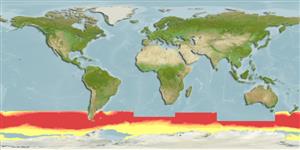>
Perciformes/Notothenioidei (Icefishes) >
Nototheniidae (Cod icefishes) > Nototheniinae
Etymology: Paranotothenia: Greek, para = near + Greek, noton = back + Greek, adverbial particle, then, that denotes distance or removal (Ref. 45335); magellanica: magellanica for the straits of Magellan, the type locality (Ref. 11892).
More on author: Forster.
Environment: milieu / climate zone / depth range / distribution range
Ecologia
marino; distribuzione batimetrica 0 - 255 m (Ref. 11892), usually 0 - 20 m (Ref. 11892). Temperate; 43°S - 78°S
Southern Ocean: southern tip of South America. Also found in Falkland, South Georgia, South Orkney, South Shetland, Prince Edward, Crozet, Kerguelen, Heard and Macquarie islands, southern New Zealand and associated islands, rarely in the Ross Sea. New Zealand and Argentina (Patagonia) (Ref. 4537)
Size / Peso / Age
Maturity: Lm ? range ? - ? cm
Max length : 43.0 cm TL maschio/sesso non determinato; (Ref. 124534); peso massimo pubblicato: 1.5 kg (Ref. 124534)
Short description
Chiavi di identificazione | Morfologia | Morfometria
Spine dorsali (totale) : 3 - 6; Raggi dorsali molli (totale) : 28 - 31; Raggi anali molli: 22 - 25. Greyish olive above, yellowish below. Pug-nosed snout, well developed supraoccipital crest, highly sculptured cranial bones. Short jaw, the maxillary not reaching the orbit, and adults with pelagic coloration as well as large epurals (Ref. 11892). Upper lateral line with 36-48 tubular scales, total number of scales in upper and middle lateral lines 45-57; caudal peduncle longer than deep, 37.0-45.5% HL; preoperculo-mandibular canal not connected with the temporal canal; dorsal surface of head without prominent ridges; pelvic length much shorter than pectorals (Ref. 37311).
Utilized as a food fish.
Dewitt, H.H., P.C. Heemstra and O. Gon, 1990. Nototheniidae. p. 279-331. In O. Gon and P.C. Heemstra (eds.) Fishes of the Southern Ocean. J.L.B. Smith Institute of Ichthyology, Grahamstown, South Africa. (Ref. 5179)
IUCN Red List Status (Ref. 130435)
Threat to humans
Harmless
Human uses
Pesca: commerciale
Strumenti
Special reports
Download XML
Fonti Internet
Estimates based on models
Preferred temperature (Ref.
123201): 3.4 - 10.8, mean 7.9 °C (based on 130 cells).
Phylogenetic diversity index (Ref.
82804): PD
50 = 0.7500 [Uniqueness, from 0.5 = low to 2.0 = high].
Bayesian length-weight: a=0.00676 (0.00401 - 0.01141), b=3.23 (3.08 - 3.38), in cm total length, based on LWR estimates for this species & (Sub)family-body (Ref.
93245).
Trophic level (Ref.
69278): 3.5 ±0.5 se; based on size and trophs of closest relatives
Generation time: 4.2 ( na - na) years. Estimated as median ln(3)/K based on 1
growth studies.
Resilienza (Ref.
120179): Medio, tempo minimo di raddoppiamento della popolazione 1.4 - 4.4 anni (K=0.26; Fec > 10,000).
Fishing Vulnerability (Ref.
59153): Moderate vulnerability (40 of 100).
Nutrients (Ref.
124155): Calcium = 38.5 [21.9, 66.7] mg/100g; Iron = 0.43 [0.26, 0.70] mg/100g; Protein = 18.2 [16.8, 19.5] %; Omega3 = 0.724 [0.440, 1.207] g/100g; Selenium = 11.9 [6.1, 23.1] μg/100g; VitaminA = 16.5 [5.2, 52.5] μg/100g; Zinc = 0.645 [0.461, 0.919] mg/100g (wet weight);
